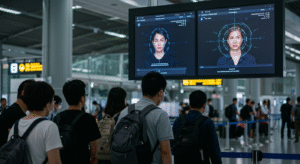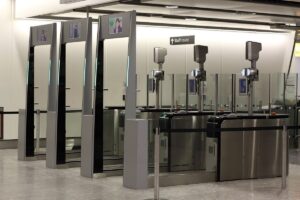Changes in immigration screening in the AI era that Canadian and Australian immigrants must know
In 2025, we are living in the age of AI. In particular, the global immigration system is changing faster and more sophisticated than ever before. At the center of this change is AI(Artificial Intelligence) The technology is taking hold.
Immigration authorities in advanced countries such as Canada, Australia, and New Zealand are already actively adopting AI in immigration screening to analyze and process thousands of applications. As a result, they are much more efficient than before. Efficient and accurate screeningIt has become possible, and real-time adjustments to immigration policy have also become more flexible.
But for immigration applicants, it’s more than just a technological advancement.
This change is clear A new opportunity and a new challenge at the same timeIn the era of algorithmic evaluation, applicants no longer have to prepare only documents. They also have to consider how AI will analyze them. Digital StrategyThis is the time when this is needed.
index
- AI Meets Immigration Adjudication: Why Was It Introduced?
- Real-world examples: Canada, Australia, New Zealand
- Benefits and Opportunities of AI Adoption
- The Risks and Controversies of AI Review
- Things to keep in mind from an immigrant perspective
- Future Outlook and Suggestions
AI Meets Immigration Adjudication: Why Was It Introduced?
The reason artificial intelligence (AI) is being fully introduced into the immigration screening system is simple.
This is because while the number of immigration applicants is growing exponentially worldwide, the number of immigration officers is not growing at the same rate.
for example, IRCC (Immigration, Refugees and Citizenship Canada)has introduced an AI-based automatic classification system to address the backlog following the pandemic.
This AI system sets review priorities based on the type of document, language, reliability of content, and basic information about the applicant (nationality, age, etc.), or automatically processes repetitive and simple review items.
This use of AI could be seen as an attempt to significantly speed up immigration review and create consistent evaluation criteria across applicants.
The Australian government too Department of Home Affairs It has an AI-assisted assessment tool in place, and New Zealand is incorporating machine learning-based analytics into its online application system.
Real-world implementations: Canada, Australia, New Zealand, and the UK
1. Canada – AI Review Technology (ART)
Immigration, Refugees and Citizenship Canada (IRCC) has in recent years AI Review Technology (ART)We are introducing a system called pre-sorting to pre-sort student and visitor visa applications.
The system automatically scans the contents of the application based on thousands of past data. “Likely to be positive” / “Needs additional review” / “Likely to be rejected”Divide into categories such as:
IRCC believes this system will reduce processing times and Ensuring fairnessIt is described as an auxiliary tool for this purpose. However, human rights groups point out that the system is opaque like a 'black box' and may have unintentional bias.
-
Chinook System: A tool that quickly processes simple, repetitive visa review tasks. Includes AI assisted algorithms
-
Used to check authenticity of documents, analyze past records, and letters of recommendation
-
Controversy: Criticism of 'bias issues' and 'opaque algorithms'
2. Australia – Digital Decision-Making and Robotic Process Automation (RPA)
The Australian Department of Home Affairs has a visa assessment system RPA (Robotic Processing Automation)and Digital Decision Assistance System, which has significantly improved the efficiency of visa screening, especially for tourist and student visas.
Already for thousands of simple visa applications Automatic approval without human reviewer intervention It's at a manageable level.
However, in 2023, there were cases where some applicants complained that they were “rejected without a clear explanation”, which led to the issue of AI’s opacity. Accordingly, the Australian government Strengthening accountability standards for AI-based decision making, was announced.
-
AI-based automated evaluation system During some pilot testing
-
Applicants for low-risk visas such as student visas and tourist visasAbout Automatic judgment system Introduction
-
Uses an internal algorithm called “Visa Risk Rating Tool”
3. New Zealand – Machine Learning-Based Automatic Classification
Immigration New Zealand will analyse the applicant's nationality, occupation, age, and previous application history to determine if the application is considered low risk. Priority review Automatically assigns to targets.
Additionally, there are reports that the detection rate of forged and altered applications has improved as AI-based document analysis systems are being utilized to detect forged documents.
-
AI-powered document validation and automatic classification System application
-
Digitization and automatic classification/verification of documents, and fraud prevention purposes
-
Still retaining the final judgment of human judges to ensure accurate judging
4. UK: Stopping automated immigration screening algorithms
The UK Home Office has introduced an AI-based automated system to classify short-term visa applicants, assessing their risk by analyzing their nationality, residence history, etc. However, the system has been criticized for producing discriminatory results based on certain nationalities or races.
Following legal challenges from digital rights groups Foxglove Legal and Open Rights Group, the UK government officially suspended the use of the algorithm in 2020. This case is considered a representative case that has raised international awareness of the bias and ethical issues surrounding AI immigration screening.
-
Visa Risk Analysis ModelApplying AI to
-
Adjust the speed and intensity of review for applicants from certain countries or with certain patterns
-
Focus on data-based risk profiling
Benefits and Opportunities of AI Adoption
AI-based immigration screening offers clear advantages:
- ① Dramatic improvement in review speed: There are also reports that it is up to 60% faster than manual processing.
- ② Cost savings: AI systems automate repetitive tasks, reducing human resources and lowering administrative costs.
- ③ Improved fairness: It can increase fairness in that judgments can be made based on the same standards, without the bias or emotional involvement of human judges.
- ④ Improved fraud and forgery detection capabilities: Machine learning can learn patterns from thousands of examples of forged documents, allowing for early detection of new frauds.
- ⑤ Big data-based predictability: By comprehensively analyzing the applicant's background information, we can predict their future social adaptability and economic contribution.
In this way, the introduction of AI can increase the efficiency and predictability of the immigration system, which can benefit both applicants and governments.
The Risks and Controversies of AI Review
Nonetheless, AI-based judging systems have their drawbacks and controversies:
- ① Opacity of judgment criteria: Most AI systems operate in a ‘black box’ fashion, with applicants unable to know what factors caused their scores to be low.
- ② Biased learning data: Because it learns from past data, it may contain biases that are disadvantageous to certain countries, ages, or occupations.
- ③ Lack of objection procedures: In the case of automated rejections, the lack of a second review by a human evaluator can make the appeal process difficult.
- ④ Data misrecognition problem: It is also possible that the system may make incorrect judgments due to translation errors or quality issues with document scans.
- ⑤ Privacy concerns: If the massive amount of personal information collected by AI is not properly protected, there is a risk of hacking and leakage.
Therefore, AI should only be used as an ‘assistant tool’, and it must be accompanied by a final human review and a balanced immigration policy.
What immigrants need to prepare for in the AI era
In an era where AI is deeply involved in immigration adjudication, applicants need to be prepared for more than just meeting the qualifications. Below are some strategies you should definitely consider.
- ① Emphasize authenticity and consistency of documents: AI is sensitive to the consistency and accuracy of data. All documents, including academic background, career, and language scores, must have the same date, format, and institution name. Any contradictory content will result in automatic deduction of points.
- ② Translation quality control: AI can inaccurately evaluate documents that have poor translation quality or smell like machine translation. Certified translator (NAATI, etc.)We recommend translation via .
- ③ Social profile management: In some countries, applicants' online information or LinkedIn profiles are used. Disclosed career informationSometimes you may also want to check the consistency of your resume, online profile, and documents.
- ④ Obtaining legal career and degree: Unusual careers/degrees are more likely to be labeled as ‘Red Flags’ by AI. The authenticity of schools and workplaces can be easily verified by AI by comparing them to public data.
In short, “honest and consistent data” is the key to success in AI review systems. As a writer, you should structure your documents with the “way a machine reads and judges” in mind, not as a human reviewer would see them.
Future Prospects
AI is expected to expand into more areas of immigration policy in the future. In particular, the following expansions are expected:
- ① Predictive scoring system: Beyond simple document screening, a system could be introduced that predicts the applicant's future employability, tax contribution, health risks, etc. and reflects this in the score.
- ② Real-time applicant analysis: AI tools are being developed to assess applicants’ integrity or risk through real-time language assessments, analysis of online interview transcripts, and more.
- ③ Blockchain-based certificate verification: To prevent forgery of degrees and career certificates, a blockchain-based original authentication system will be combined with AI to ensure accurate verification.
Ultimately, AI will make immigration screening more precise and personalized, but it could also become a double-edged sword of “emotionless machine judgment.”
Conclusion: Human-Centered Technology Convergence Is the Answer
The introduction of AI is a powerful tool that can make immigration processes more transparent and expedited. It can quickly sort through large volumes of applications and detect errors or misinformation with far greater accuracy than humans. However, technology itself is not a perfect solution. Rather, without human-centered ethical design and ongoing monitoring, AI can unintentionally become a tool for biased or unfair judgments.
Since AI operates based on past data, biases and imbalances that exist in existing systems and data can be directly reflected in the algorithm. This also creates a risk that certain nationalities, races, and occupations will be unfairly disadvantaged. Therefore, policymakers and technology developers should not simply pursue efficiency, but also introduce designs that consider diversity and fairness, as well as transparent verification systems.
Immigration applicants are now faced with a new environment where they have to go beyond the era of ‘just preparing documents’ and be aware of how AI will evaluate them and respond strategically. This means that strategies that consider not only formal qualifications but also factors that AI can indirectly refer to, such as digital footprints, language skills, and online profiles, are necessary.
As advanced countries such as Canada, Australia, and New Zealand gradually expand AI-based screening, we are seeing that it is not just a simple technological change. A Shift in the Immigration ParadigmWe are witnessing that immigration is now moving beyond the face-to-face structure of ‘human versus government’ to a new game of ‘human versus algorithm.’
Ultimately, technology is a means, not an end. In order to continue a fair and humane screening process, a structure in which technology and humans collaborate, and the ability of individuals to express themselves technically, are important. Now is the time for a more accurate, honest, and smart immigration strategy. And at the core of this strategy is always person, and understanding people technologyThis is a must have.
Reference links:
– Official Information on Canadian Immigration Processing Times
– Australian Department of Home Affairs AI Policy Overview
– Guide to AI Applications by Immigration New Zealand
Technology is changing immigration, and ultimately, those who are best prepared will get the opportunity.
*Australian Immigration Type Conditions Shortcut




